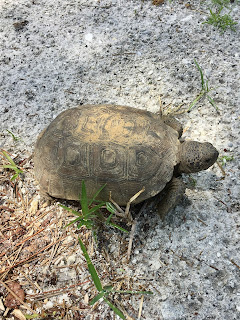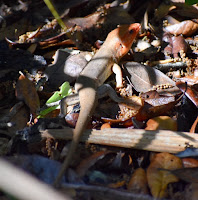Flashback 3 St. Johns County, FL
When my younger daughter was attending college in St. Augustine, FL, I got to visit her often. I spent many days out birding the area while she was on campus. St. Augustine is on the northeast coast of Florida, roughly a 50-minute drive south from Jacksonville. It is the county seat of St. Johns County and the oldest city in the United States. It is one of my favorite places to visit. There are many birding hotspots nearby and the ones I frequented most often were Anastasia State Park, Masters Tract Stormwater Treatment area on Hub Bailey Road and Guana Tolomato Matanzas National Estuarine Research Reserve (GTM NERR).
Today I look back at one day walking through part of the large GTM NERR expanse. GTM is located in beautiful Ponte Vedra Beach, about a 40-minute drive from St. Augustine. GTM covers over 76,000 acres and lists over 350 bird species, dozens of reptiles and amphibians and over 500 plant species. It was at GTM in 2017 that I found my first pileated woodpecker and brown-headed nuthatch. However, it was an August afternoon in 2018 that I am reminiscing now. It was a rather mundane day at GTM for Florida birding, my eBird list for that day was only 22 species and all of which I could have also seen in New Jersey. However, it was another nature encounter that I recall so vividly.
I was about an hour into my walk, maybe about halfway through the five-plus miles I covered that day. I'm not sure exactly how far from the trail head I was, but it was in the same spot I was where I spotted the pileated woodpecker and brown-headed nuthatch about ten months earlier. Having no luck finding those two birds again, I continued along the trail. Just a hundred yards or two ahead I had to walk around a tree that was in the middle of the trail. I stopped when I heard a strange sound. It took a few seconds for the sound to register in my mind. It was an Eastern diamondback rattlesnake.
I had never encountered a rattlesnake, but trust me, when you hear that tail rattling, you know. Needless to say, the hair on the back of my neck began to rise. Unlike rushing into a burning building or driving the NJ Turnpike during morning rush hour, this was a whole other level of scary. I had no idea where it was, and while frozen in my stance, I glanced down and there it was. About six feet away from where I stood, coiled up and shaking its tail. Instantly, I felt the coolness in my extremities as my blood began to recede. I don't want to use expletives here, but my mind was filled with them. I stood motionless as the seconds felt like minutes. From what I remembered; rattlesnakes can only strike from a coiled position. Great, it was like a pistol with the hammer pulled back. I knew that the snake's rattle was its way of saying, "This is your last warning before I strike."
I had to move and move quick. As the snake was in front of me, and logs and trees were behind me, my only options were laterally left or right. With a long sidestep right, followed by a couple really quick middle-aged fleeing man steps more, I stopped. I looked back and the snake was holding its position. Whew!
Now, this is when I have to say, don't try this on your own. After safely escaping harm's way, I allowed my insanity to overcome me. I needed a picture. I took a few steps back towards the snake and snapped a shot. The snake rattled again. Enough said. I quickly retreated again and continued along the trail.







Comments
Post a Comment